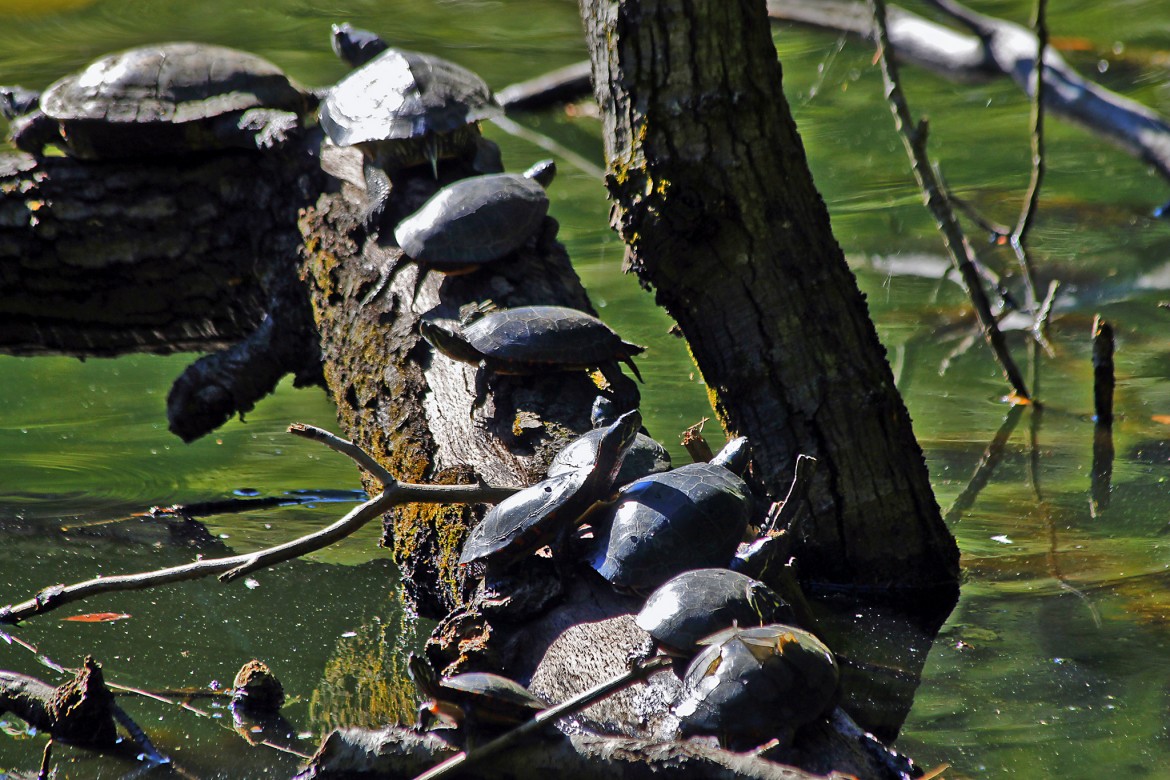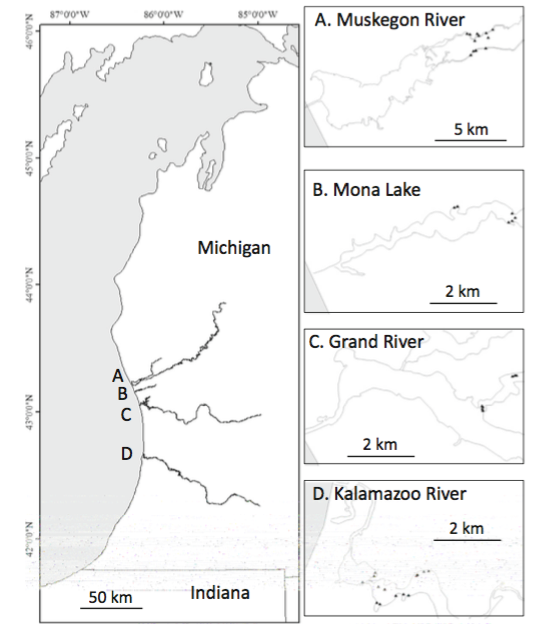By MARIE ORTTENBURGER
Capital News Service
LANSING — You likely won’t find any painted and snapping turtles headbanging to Metallica in Lake Michigan wetlands.
But heavy metal runs in their veins.
These turtles accumulate heavy metals in their tissues, according to a recent study in Environmental Monitoring and Assessment. Some of those metals come from local industries such as smelters, refineries and foundries, as well as landfills, storm sewers and farm runoff.

Basking painted turtles. Image: Jack Pearce, Flickr.
“There’s reason to believe the levels of metals like cadmium, chromium, copper and lead are impacted by anthropogenic sources,” said Matt Cooper, a research scientist at Northland College’s Burke Center for Freshwater Innovation in Ashland, Wisconsin, and co-author of the study. “They are much higher than would occur naturally, and the geology in the areas they were studying wasn’t known to have high levels of those contaminants.”
Researchers tested turtles from wetlands at the mouths of the Grand, Muskegon and Kalamazoo rivers where they empty into Lake Michigan, as well as from wetlands surrounding Mona Lake in Muskegon County.
Those wetlands were chosen based on watershed land use and closeness to industrial areas. In addition, the study said that Mona Lake’s watershed “has substantial urban and industrial land use, and previous studies have shown high levels of heavy metal contamination in the sediments of the wetlands.”
“Based on personal knowledge and data from previous projects we knew these sites had turtles and lots of them,” said Jessica Kosiara, graduate research assistant at Central Michigan University in an email. “These sites also represent a gradient of human activity. We hypothesized that sites with a high degree of industrial activity in the watershed would have turtles with high body burdens of metals.”
Bearing the burdens of these metals could shorten turtle lifespans and make them less fertile, although those impacts on painted and snapping turtles have not yet been measured.
“There is little evidence of how different metals affect physiology or how heavy of a body burden it takes to have an impact,” Kosiara said.
“Right now, we can only really make guesses,” said Dayna Smith, a Western Illinois University biologist and a study co-author.

Wetlands testing areas for Lake Michigan Turtles: Credit: Environemntal Monitoring & Assessment
In fact, freshwater turtles have been a bit neglected by research. Arriving at meaningful conclusions about how they accumulate metal was difficult because the researchers had few studies to build on.
“We had to search far and wide to even find data,” Cooper said.
They ended up comparing their results to studies of freshwater turtles in Kentucky and Iran, which enabled them to arrive at the conclusion that “Lake Michigan wetland turtles have moderate levels of heavy metal body burdens and some metals, such as copper, appear to be relatively high in these animals.”
Smith said, “Freshwater turtles are very understudied.”
Part of the reason is that until now, turtles have been difficult to sample. It wasn’t clear if tissue could be obtained without collecting whole turtles and killing them.
The new study measured metals in shell and claw samples and found that they corresponded with levels in liver and muscle tissues. Metal contamination could be monitored by just clipping shells and toenails in the field – and without killing the turtles.
Cooper said more research is needed before an ongoing metal monitoring program for freshwater turtles can begin.
The new study “is a good first step,” Cooper said. “There’s a lot more work that can be done.”
Kosiara said, “I think the results from this study can spur more conversation and interest in understanding how the health of these turtles may be affected by heavy metals associated with human activity.”.
Expanding the research is important, Smith agreed. Fish, plants, and bugs are studied, but the little-studied turtles could supplement that research.
“They do represent an important part of the food web,” Smith said.
Another reason for more research on freshwater turtles, particularly regarding how they accumulate heavy metals, is that many people eat snapping turtles.
Cooper said the study proved that turtles carry heavy metals in their tissue, but there are yet many unknowns about how that might harm people. For example, scientists don’t know if turtles carry dangerous contaminants like mercury or the degree to which people eat them in the Great Lakes region.
“There’s a lot of room for growth in turtle research,” Smith said. “I hope that they are studied more.”
Marie Orttenburger writes for Great Lakes Echo
ADDITIONAL RESOURCES FOR CNS EDITORS
“Body burdens of heavy metals in Lake Michigan wetland
Turtles”: http://link.springer.com/article/10.1007/s10661-016-5118-5/fulltext.html